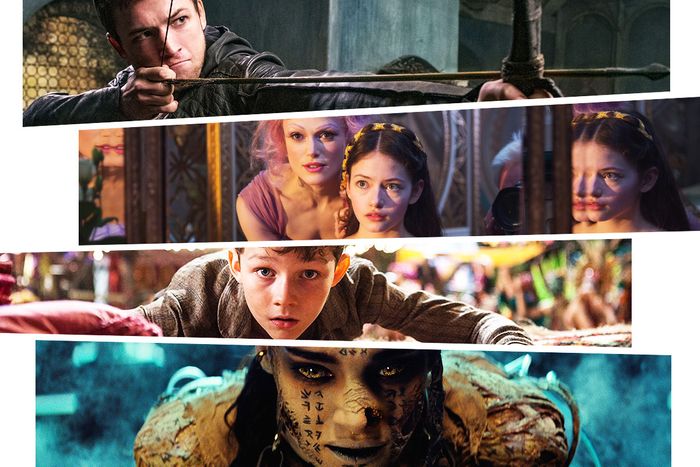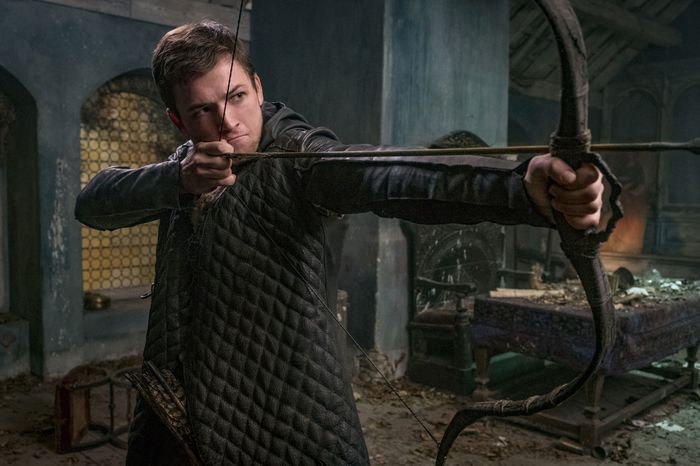
In the old days, stars were the fuel that made the movies shine; now, its intellectual property. A few decades ago, the powers that run Hollywood realized that the easiest way to make money was to pretty much to only make movies based on things audiences had already heard of. Though there have been misfires along the way, IP has since achieved hegemony over the multiplex: On the list of 2017s highest-grossing films, you have to go down to No. 13 (Coco), to find an original idea. Some films  remakes, say, or comic-book movies  do not need to sweat too hard contorting themselves to fit the new realities. But then there are other properties where you can practically hear the boardroom discussion: Weve got the rights  now what? In my head, I call these IP-busters (I dont expect it to catch on), films that only exist because hey, the studios got to release 16 movies a year, so why not take a swing before someone else does?
For whatever reason, there is some intellectual property where a straight redo simply will not work. Maybe itÔÇÖs been tried before, and failed. Or maybe the old version is way too problematic for the current day. Either way, if you find yourself tasked with developing one of these movies, there are five general approaches you can take. Choose wisely: The fate of your job may depend on it.
1. Make it a fantasy epic!
This week, Disney will celebrate the holidays by releasing The Nutcracker and the Four Realms, Lasse Hallstr├ÂmÔÇÖs loose adaptation of Marius Petipa, Lev Ivanov, and Pyotr Ilyich TchaikovskyÔÇÖs The Nutcracker ballet, which is an adaptation of Alexandre DumasÔÇÖs ÔÇ£The Story of a Nutcracker,ÔÇØ which is itself an adaptation of E.T.A. HoffmannÔÇÖs ÔÇ£The Nutcracker and the Mouse King.ÔÇØ ThatÔÇÖs a lot of source material to pull from, but the film jettisons basically all of it. Instead of seven-headed mouse kings and sugar-filled balls, Hallstr├Âm brings us yet another story about warring fantasy kingdoms, filled with CGI soldiers marching in lockstep. You see, Mother Ginger is a separatist warlord whose Land of Amusements is in open rebellion against the Land of Snowflakes, the Land of Flowers, and the Land of Sweets ÔǪ
Since the Lord of the Rings trilogy crafted a workable model for epic fantasy onscreen, a number of public-domain stories have been poured into this mold. Snow White and the Huntsman added catapults and cavalry charges to the Brothers Grimm fairy tale, while Tim BurtonÔÇÖs Alice in Wonderland gave us not only the violent battles that Lewis CarrollÔÇÖs book lacked, but also threw in an ancient prophecy about a legendary hero to boot. You could even include the Hobbit films, which pulled and stretched J.R.R. TolkienÔÇÖs original story until it had turned into a trilogy rivaling its predecessor in scale. YouÔÇÖll notice that basically all of these films made a ton of money, which goes most of the way to explaining why people keep doing this. ThatÔÇÖs, uh, not something you can say about most of the IP-busters to come on this list.
2. Get Guy Ritchie (or his cheaper equivalent) to direct!
November 21 brings a new version of Robin Hood, this one with KingsmanÔÇÖs Taron Egerton as the eponymous redistributor of wealth, Jamie Foxx as Little John, and Ben Mendelsohn as the Sheriff of Nottingham. ItÔÇÖs the first feature from British director Otto Bathurst, who previously helmed episodes of Black Mirror and Peaky Blinders, but based on the trailer the film seems to take clear inspiration from the IP-busters of Guy Ritchie, who has spent the past decade carving a prominent niche with stylized adaptations of Sherlock Holmes, The Man From U.N.C.L.E., and King Arthur. The Snatch filmmaker will soon bring his characteristic laddish energy and hyperkinetic editing to Aladdin, turning the tale of the Arabian street-rat into what one Disney exec has called a ÔÇ£highly energized Guy Ritchie Disney musical.ÔÇØ
3. Prequel-ize it!
To paraphrase Patton Oswalt, if an audience loves seeing a character doing cool stuff, you can bet theyÔÇÖll also love sitting through a movie about all the stuff they did before they got to the cool stuff. A few years ago, when cinematic universes were starting to get big, a few would-be Creators had the idea that the road to box-office gold was paved with origin stories. Why waste the version of the story everyone knew, when you could save it for the sequel? Accordingly, during the second term of President Obama, audiences were treated to a string of would-be franchise starters. There was Pan, which gave us Peter Pan and Captain Hook as close friends; Dracula Untold, which detailed exactly how that guy Vlad became a vampire; Victor Frankenstein, which dramatized the meeting of the infamous doctor and his assistant Igor; and Oz: The Great and Powerful, which explained both how the Wizard made it to Oz┬áand how the Wicked Witch of the West became wicked (not like that). None of these efforts were quite the cinematic Big Bang their creators had hoped, as the quartet of films combined to produce exactly zero sequels.
4. Sequel-ize it!
If a prequel wonÔÇÖt do, a sequel might. For instance, take 2016ÔÇÖs The Legend of Tarzan, which picked up after the titular vine-swinger had already returned to his native Britain and become famous for his African adventures. (The movie then sends him right back, making you wonder what the point was.) But mostly, this is a model thatÔÇÖs used for family films, under what we might call the Hook Corollary, in which we follow the grown-up versions of characters who were kids in the original. Disney, in its infinite wisdom, is pulling it off twice this year, giving us disillusioned adults reuniting with the ageless figure who delighted them as children in both Christopher Robin and the upcoming Mary Poppins Returns. The new Nutcracker fits here, too, as it follows the daughter of the main character in the original Nutcracker returning to her motherÔÇÖs kingdom to set it right.
5. Move it to the present day!
If none of these work, simply throw up your hands, and transport the earlier action to the present day. This seems to be something of a Plan Z when it comes to IP-busters, judging by the misbegotten films that have employed it. Consider 2014ÔÇÖs I, Frankenstein, which asked the question, ÔÇ£What if FrankensteinÔÇÖs monster had lived into the 21st century, and fought demons?ÔÇØ; or 2017ÔÇÖs The Mummy, which attempted to kick-start UniversalÔÇÖs Dark Universe with Tom Cruise discovering a sarcophagus in modern-day Iraq. But my favorite attempt at a contemporary retelling is the one teased in the final scene of Dracula Untold, in which Luke Evans runs into the reincarnation of his long-dead wife on the streets of London, at which point Charles Dance, as the vampire who turned Vlad (and who was at one point supposed to also be the Roman emperor Caligula), shows up to mutter, ÔÇ£Let the games begin.ÔÇØ ItÔÇÖs a vestige of the time when Dracula Untold was supposed to launch the Dark Universe, before its failure led to The Mummy taking that role, only for The MummyÔÇÖs failure to inspire Universal to scrap the whole plan entirely. In other words, the scene only exists to set up a movie that did not happen, which was supposed to tie into four or five more movies, most of which also did not happen. I can think of no better summation for both the grand ambitions, and the oft-frustrating execution, of the IP era.







